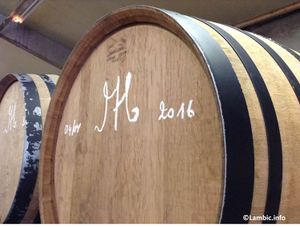Meerts

Overview
Meerts, or Bière de Mars in French, is a low strength beer produced following Lambic production methods. Historically this beer would have been brewed at the same time as Lambic, with the wort coming from the later runnings of a Lambic mash (see also Brewing Lambic). Meerts is spontaneously fermented and was traditionally blended with Lambic to make Faro[1]. While Meerts has almost disappeared, it is still produced by Brouwerij Boon (Boon Meerts) and incorporated into Gueuze Tilquin (Draught Version), Tilquin Faro, Quetsche Tilquin (Draught Version) and Mûre Tilquin (Draught Version) at Gueuzerie Tilquin.
Brewing Meerts
Historic Production
Meerts was traditionally a product from the later runnings of a lambic mash[1]. As the extractable sugar levels decrease with continued rinsing of the grains during the sparging process, subsequent mash runnings have progressing lower original gravities (lower levels of sugars for fermentation). The sugar-rich early runnings of the mash would be used for producing Lambic, leaving the later runnings for Meerts. This means that while the wort for lambic underwent a turbid mash, the wort for Meerts was produced only by rinsing residual sugars out of the grain left over from lambic production. Therefore, most of the soluble material from a turbid mash would have been transferred to the lambic wort and the insoluble material would remain behind with the spent grain after extraction of wort for both of these beers.
These two different worts of lambic and Meerts would then be boiled separately. Meerts wort was hopped at a lower level than Lambic (4-5 g/L for Meerts compared to 7.6-8.6 g/L for lambic). But it should be noted that this hopping rate is higher than many some Lambic producers are using (see e.g. [2]). Additionally, the Meerts boil would receive the hops used during the Lambic boil once the Lambic had been sent to the coolship. Meerts was cooled in a coolship and spontaneously fermented as with Lambic. The boil duration for Meerts was considerably longer than lambic (12-15 hours for Meerts compared to 4-6 hours for lambic) as the Meerts wort would need to wait until the lambic wort had been removed from the coolship before Meerts could be cooled[1] (see also[3][4]).
References to a beer called "Naar goed", made from the later runnings of a lambic mash, can be found at least as far back as the 1820s[5]. By the mid 1800s, this final runnings beer is referred to as "Bière de Mars" in French-language brewing texts. Bière de Mars had an original gravity around 5 P[1], or about 1.020, and a final ABV around 2-2.5% ABV.
Modern Production
Today, Meerts is only produced by one Lambic brewer: Brouwerij Boon. Low gravity beers from the later runnings of a Lambic mash are no longer produced by Lambic brewers. and the Boon Meerts is brewed as a stand alone beer rather than as a portion of the wort from a Lambic brewday. This likely alters the carbohydrate composition of the Meerts, as modern Meerts goes through a full turbid mash on its own instead of being the final rinses of a grain bed from Lambic wort.
Consuming Meerts
Meerts was an integral part of Faro production in the mid 1800s, with Faro was described as a 50/50 blend of lambic and Meerts. This blending was usually done after fermentation, but there is also mention of some brewers blending before fermentation[1]. Although modern Faro is almost always only produced from lambic, the Faro produced by Gueuzerie Tilquin is a 50/50 blend of Lambic and Meerts[6]. Meerts is also used to produce the draught beers at Gueuzerie Tilquin.
References
- ↑ Jump up to: 1.0 1.1 1.2 1.3 1.4 Lacambre. Traite Complet de le Fabrication des Bières et de la Distillation des Grains, Pommes de Terre, Vins, Betteraves, Mélasses, etc. Tome Premier. 1851
- ↑ Hors Catégorie Brewing blog post: Hops in Spontaneous Fermentation
- ↑ Hors Catégorie Brewing blog post: Bière de Mars and Lambic part 1
- ↑ Hors Catégorie Brewing blog post: Bière de Mars and Lambic part 2
- ↑ Nieuwe Verhandelingen van het Bataafsch Genootschap der Proefondervindelijke Wijsbegeerte te Rotterdam. Zevende Deel. 1829
- ↑ Conversation between P. Tilquin and D. Janssen, May 2014.